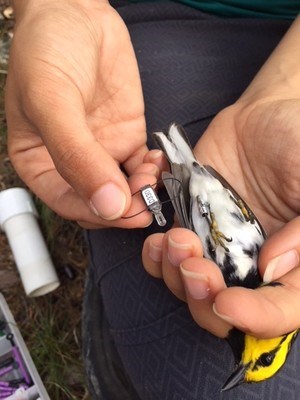JBSA Natural Resource office spotlights endangered bird species

The JBSA Natural Resource office, which comes under the 802nd Civil Engineer Squadron, has been surveying and monitoring the golden-cheeked warbler during their breeding season for almost 30 years. The JBSA Natural Resource staff along with their cooperator, the Texas A&M Natural Resource Institute and collaborators at Louisiana State University, have implemented surveys and color banding to acquire estimated population densities, territory and nest monitoring, return rates and reproductive success of the species. (Photo by Shannon Carrasco)
May 11 was International Migratory Bird Day and the Joint Base San Antonio Natural Resource office wants to highlight Texas’ native migrant, the golden-cheeked warbler, also known as Setophaga chrysoparia.
The golden-cheeked warbler is a small insectivorous – which means it feeds primarily on insects and spiders – songbird that migrates thousands of miles from El Salvador, Guatemala, Nicaragua, Honduras and Mexico every March to breed and nest exclusively throughout central Texas, including JBSA-Camp Bullis.
These warblers build their nests in thick mature oak/juniper woodlands, using the stripping bark from the Ashe juniper, otherwise known as “mountain cedar.”
Being that the Ashe juniper is one of Texas’s most hated trees, causing “cedar” allergies and having low-growing limbs that make it difficult for humans and livestock to pass through, these trees are commonly cut down by land owners and developers, which has been the main cause for this bird’s loss of habitat. That has resulted in their federal listing as “endangered” in 1990.
According to the U.S. Fish and Wildlife Service website, about 27,000 warblers exist today, which represents a decline of about 25 percent in the past 28 years.
The JBSA Natural Resource office, which comes under the 802nd Civil Engineer Squadron, has been surveying and monitoring the golden-cheeked warbler during their breeding season for almost 30 years.
Currently, the JBSA Natural Resource staff along with their cooperator, the Texas A&M Natural Resource Institute and collaborators at Louisiana State University, have implemented surveys and color banding to acquire estimated population densities, territory and nest monitoring, return rates and reproductive success of the species.
These surveys are done in compliance with several laws and regulations, including the Endangered Species Act, Sikes Act, Department of Defense Instruction 4715.03, Air Force Instruction 32-7064, the goals and objectives of the JBSA Integrated Natural Resource Management Plan, and the U.S. Fish and Wildlife Service Endangered Species permit for JBSA.
JBSA-Camp Bullis currently has about 8,300 acres of designated golden-cheeked warbler habitat, which is the largest block of protected habitat in the species’ recovery unit 6.
In 2017, JBSA-Camp Bullis collaborated with the U.S. Army at Fort Hood to use the same survey methodologies and habitat delineations for direct comparison of data.
Also in 2017, JBSA-Camp Bullis began participating in Fort Hood’s golden-cheeked warbler geolocator project by deploying small solar trackers on the birds to study their migratory timing, connectivity, and movement from their breeding grounds on to their wintering grounds in Southern Mexico and Central America.
The geolocators collect solar data, which can be used to approximate the latitude and longitude of the bird’s location as it travels between the breeding and wintering grounds. The location information can then be used to identify the strength of migratory connectivity for golden-cheeked warblers.
The data collected from this study will help address one of the most important unanswered research questions for this species and has important implications for management and conservation on both their breeding and wintering grounds.
Because of these efforts, a diverse team golden-cheeked warbler researchers have been brought together to include Fort Hood, U.S. Fish and Wildlife Service, Texas A&M Natural Resource Institute, Louisiana State University and JBSA-Camp Bullis. Partnerships such as these are critical components to the recovery and potential delisting of this species.
--
Originally published: JBSA News
Written by: Shannon Carrasco | Joint Base San Antonio Natural Resources Specialist


